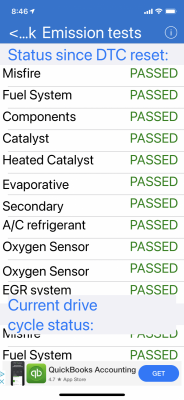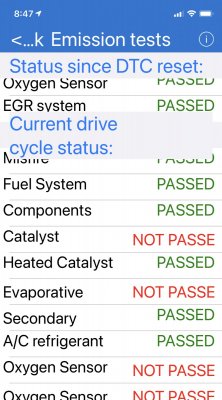I realized I had hijacked a thread on Tahoe/Yukon longevity with a complete side track of how the Range device affects emissions testing readiness when it is pulled out before you go in for an emissions test, so I thought I would move things over here (if anyone really cares.  ).
).
There have been a few posts on how pulling the Range device out of the ODBII port affects the emissions readiness status. Some have been able to pull it just before testing and pass no problem, others mention they need to drive around for like a week with it out, before going in for the test.
In my personal experience, this is what I have noticed with my 2007 Yukon, 5.3L (LMG) Flex Fuel engine and my Range dongle.
Here are the results on my $20 ODBII scanner, after pulling my Range AFM Delete device out, like I would before going in fo my test.


I tried warming the car up to see if the Not Passed would clear and they remained. I have located a generic GM Trip criteria and will try it when I get some time and can drive it for 15 minutes or so to perform the standard GM Trip and report back what happens.
My goal is to figure how exactly how little I need to drive it in AFM mode to clear all the flags, before I take it in for emissions tests. My concern is with the AFM deleted with the Range device, I worry that oil sludge has a chance to build up in the oil manifold and may impact AFM performance during the time I am driving the car around clearing the emissions readiness flags. I frankly think this concern may be unfounded, given all the reports by other members of this forum of successful use of the Range device for a very long time. But being a belt and suspenders kind of person, I want to do all I can to eliminate this concern.
I figured out how to upload screen shots pretty easily now, so as soon as I have the trip completed, I will post the results.
There have been a few posts on how pulling the Range device out of the ODBII port affects the emissions readiness status. Some have been able to pull it just before testing and pass no problem, others mention they need to drive around for like a week with it out, before going in for the test.
In my personal experience, this is what I have noticed with my 2007 Yukon, 5.3L (LMG) Flex Fuel engine and my Range dongle.
Here are the results on my $20 ODBII scanner, after pulling my Range AFM Delete device out, like I would before going in fo my test.


I tried warming the car up to see if the Not Passed would clear and they remained. I have located a generic GM Trip criteria and will try it when I get some time and can drive it for 15 minutes or so to perform the standard GM Trip and report back what happens.
My goal is to figure how exactly how little I need to drive it in AFM mode to clear all the flags, before I take it in for emissions tests. My concern is with the AFM deleted with the Range device, I worry that oil sludge has a chance to build up in the oil manifold and may impact AFM performance during the time I am driving the car around clearing the emissions readiness flags. I frankly think this concern may be unfounded, given all the reports by other members of this forum of successful use of the Range device for a very long time. But being a belt and suspenders kind of person, I want to do all I can to eliminate this concern.
I figured out how to upload screen shots pretty easily now, so as soon as I have the trip completed, I will post the results.
